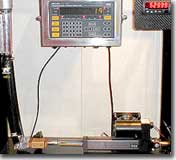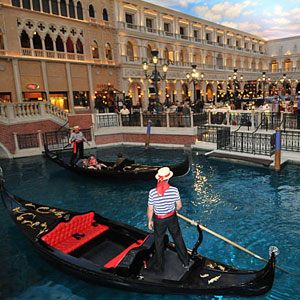Tempted by Tri?
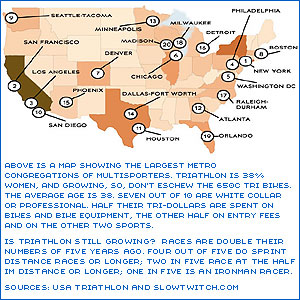
What follows was the feature article in the 2009 Interbike Show Guide. After much request for its publication by those who did not have a chance to read it, we asked for, and Interbike granted, permission for its publication here. Interbike is the premier trade show worldwide for the bicycle industry. Bear in mind, the target audience for this article is the shop that offers for sale triathlon's goods and services.
Triathlon is the lusty category retailers would most love to be in. It holds out the promise of incremental revenues, good margins, and an attractive set of customers. But it's as scary as it is sexy, if you're a retailer on the outside looking in. Triathletes can sniff out the culturally uncool bike seller and retailers know it. Only those who seem to solve triathlon's alchemy effectively compete in this market. But is it really that hard?
Cultural coolness is not achievable through reading an article over morning coffee and danish. I can't teach you to break dance and moonwalk over the course of four pages, but I can show you the steps. There are tasks to accomplish during Interbike, and I'll tell you what they are. If you follow my lead, you'll leave Interbike a much stronger brand than when you arrived. Notice I referred to you as a brand. Let's start with this.
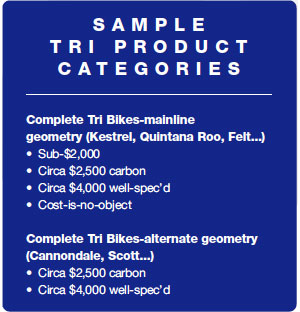
YOU ARE THE BRAND
The first, best thing you can learn is: There is no single brand of bike or wetsuit you must have in your store. You, the retailer, are the brand. Customers will flow to you, or not, based on what you know more than what you sell. Think less about bike and wetsuit companies, think more about bike and wetsuit categories. One such category might be the circa-$2,200 carbon-frame complete tri bike. Felt, Quintana Roo, Cervelo, Kuota, Cannondale and others all make ready-to-ride carbon bikes within $300 on either side of this price. Less important than the brand of bike in your store is whether you have any bike in this category in your store. This is an important category; best if you're not shut out here.
Just as in road race, triathlon has predictable categories. What about a largely Dura-Ace or SRAM Red tri bike in the $3,500 – $4,500 price range? Then there's the cost-no-object bike; the sub-$200 sleeveless wetsuit; the entry-level full wetsuit; the cost-no-object fullsuit.
These are important categories. Whether you invest in blueseventy's entry-level longjohn tri wetsuit or 2XU's entry level; or those made by QR or Nineteen; this is less important than just having somebody's longjohn in this all-important category. Adhere to these three rules: Are the important categories filled? Will the models you carry fit your typical customer? Are you comfortable doing business with your flagship tri-equipment suppliers?
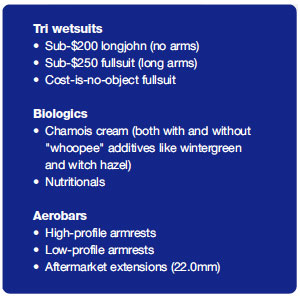
DON'T DATE AROUND
If you really are a brand, then you stand for something. I've seen a lot of retailers try to grab as many attractive lines as they can in an attempt to freeze out the upstart shop on the other side of town. Retailers who engage in this wake up one day to realize they no longer stand for anything—they stand for everything. My advice: Don't engage in this. When it comes to triathlon, don't date eight or ten bike manufacturers. Rather, marry three or four of them. Why? Because in this economy your open-to-buy is a little more "closed" than it used to be, but your important bike suppliers haven't relaxed their thoughts on what your annual commitment should be. Remember, the goal is to "fill your categories." You can do this with three or four bike brands.
I've been well guided by a longstanding truism: Invest loyalty where it's been invested in you. Do you have a reliable supplier, who does not over-saturate your territory; who packs, ships, invoices correctly and timely; who does not run away from its warranty responsibilities? If you have six tri bike lines in your store, drop one or two that don't match this description and double up on the ones that do. Reward the loyalty that's been earned. When push comes to shove, when it's a close call, when you need a favor from your flagship supplier or the tie needs to go to you, loyalty will come back to reward you.
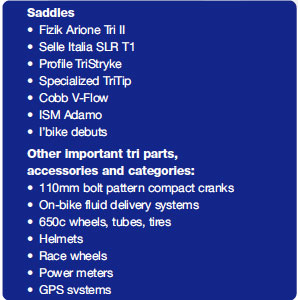
ESTABLISH YOUR FIT PHILOSOPHY
Now that I've waxed business-philosophic, let me retreat for a caveat: Bikes and wetsuits must fit your customers. More than that, they must fit according to how you think they should fit. Remember, you are the brand. Your triathlon customers are not as sophisticated as you fear they are. They'll come in asking for a Transition, Plasma, Airfoil, Slice, Equinox TTX, but they won't have any idea how to fit aboard them!
And that's where you come in. Yes, the $2200 carbon tri bike is an important category and, yes, you’ll fill it with a model built by a company you trust. But let me ask you this: How—and who—does a Cannondale Slice fit? How and who does an Equinox TTX or a Specialized Transition fit? You need to determine— for yourself and your shop—a fit philosophy. And here’s a warning: deviate from the mainstream at your own peril. School yourself in how the leading edge of triathletes ride their tri bikes these days, and sidle up to it. There is no mystery here. There is a convergence today on how tri bikes ought to be ridden. But many of your customers are still confused or, at least, unsure about fit, and they’ll look to you for guidance.
Currently, there are a few distinct camps of tri-bike fit philosophy. A group of manufacturers including, namely, Cervelo, Felt, Quintana Roo, Kestrel, Fuji, Ridley, and Jamis all make bikes that fit a certain way that we call “long and low”. Scott, Cannondale and others make bikes that fit another distinct way “narrow and tall”. Both styles of bikes are necessary if you want to fit all your customers. Orbea, Pinarello, Time, De Rosa and others fit yet a third way.
I’ll bet you didn’t know that, did you? Neither do most of your customers. The onus is on you to understand these three distinct geometric camps, and to identify the profile of your customer and match him to one of the geometric categories above. It’s not that hard. We’ve published several articles on Slowtwitch.com that describe all of this succinctly and make a good read over morning coffee and Danish.
The take-away here is this: headbadges are important; margins are important; timely shipping is important; but you can’t ride a headbadge or a margin. At some point, your customer hikes his leg over the top tube and, by golly, the bike better fit him. Make sure that bike is one that you carry in your store.
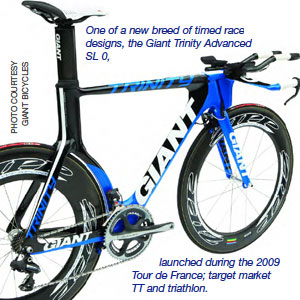
MAJOR IN THE MAJORS
Focus, my friends. Do not major in the minors. And what are the major elements, at least in regards to tri bikes? Your customer is going to want an all-carbon bike with aero tubes if he has the bank to buy one. But these are the minors whether he understands this or not. There are three elements that are much more important to his riding happiness and success.
First, does the bike fit? Many of you (about 500 fitters in 200 stores across North America) have been out to our “compound” for our two-day workshops teaching tri bike fit. This process is teachable, it’s learnable, and whether you learn this at our workshop, through Serotta’s SICI program, via Michael Sylvester’s excellent schools for Trek retailers or the Specialized Body Geometry curriculum, learn tri bike fit. If you prefer to be an autodidact, you’ll find everything you need to know on the web. But learn it you must. Remember, you are the brand. But the brand is no good—the brand commands no premium, that is—if there’s nothing behind it. Any Cervelo dealer can sell a P2. But how many dealers can fit their customers properly to this excellent bike? If you’re one of them, this is your brand equity.
Fit is only the first of three elements that you need to consider. The second is “point tenderness.” Even if your customer’s fit coordinates are spot on, there are places he contacts the bike and these need to be ergonomically correct. There are maybe six or eight specific models of saddles that work best for almost all triathletes (not including the saddles that will debut as this year’s Interbike that I haven’t seen yet). Do you know what saddles those are? Take a look at the sidebar on saddles for my list. September in Las Vegas is a good time to visit these booths and see them in person!
Finally, let’s talk friction. You need to solve the friction problem whether it’s between your customer’s neck and his wetsuit, or between his trunk and his cycling shorts. Triathletes suffer from this more acutely than other cyclists because they rest their weight on tender places. Inoculate yourself from a failed fit session by having chamois cream and other biologics at the ready in your store. Decide which you’ll carry as you make the rounds of the booths at Interbike.

ARMOR FOR THE AISLES
As you walk the aisles of this year’s Interbike, it's best if you approach this like any other battle you fight. Go in with a strategy. Write down what it is you want to achieve. Identify categories you need to fill. Deploy your troops accordingly.
This is not alchemy. It is not art. Tri bikes are built with a wider geometric range, brand to brand, because your customers rest their weight skeletally on the front and back of their bikes. This makes a tri bike a (sort of) front recumbent, and it allows for a greater available range, fore-aft, than is the case on a road race bike. That established, athletes tend to aggregate toward a particular point along this gradient of shallow to steep. The better selling brands anticipate this and tend to design bikes with this in mind. Consider this before you commit to your pre-season size runs.
Again, though, it’s about covering the bases and filling the categories. When it comes to tri bikes, Cannondales don’t fit like Felts, but each brand’s tri geometry is well-conceived. The enterprising retailer carries at least one “Cannondale-style” tri bike line along with his Felt/Cervelo style bikes so that all his bases are covered. Just as tri bikes are built in a range of geometries, so are aerobars. The top of an aerobar armrest may sit two centimeters above the centerline of the pursuit bar. Another might sit seven centimeters above it. Which is the better geometry? It depends. Does a customer lust for a “tall” tri bike you carry, but he can’t get the bike’s front end low enough, even with a minus-17° stem? How about replacing the high-profile aerobar that came OE with a low-profile bar? This knowledge—this savvy—is what makes you the brand.
When I was a bike manufacturer, my staff would never let me pick the color schemes. This, they said, was because I apparently lack the gene to understand sex appeal. Sure, a lot of bike buying is based on sexy paint, but the bike gets a lot less sexy when discomfort drives you out of the aero bars and onto the pursuit bars (cow-horns) five miles into the ride. Yes, the cosmetics are important, but I’m a nuts and bolts guy, and I think you should be too.
My admonition, then, is to take what I've presented and with the help of the exhibitor lists and floorplan here in the Event Guide and online, start making notes and a plan of attack. I've also provided some lists of important triathlon gear and accessory categories to consider as you grow your store's tri offerings in the sidebars. Then you’ll be armed and ready for Interbike’s aisles.



